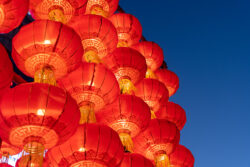Chinese New Year is almost here. (Picture: Getty Images)
Have you ever wondered what you should say to your friends to wish them a happy Chinese New Year?
Perhaps you’ve heard well-wishers say things like ‘gong hei fat choy’ (or a similar greeting) and wondered what it meant.
Just for the record – ‘gong hei fat choy’, as one of the most frequently uttered greetings, does not mean ‘happy new year’ at all.
So if you’re in need of some handy CNY greetings to say to your Chinese friends or simply want to get in on the action, here are some of the things you could say on February 1 (and don’t worry about getting it wrong – your friends will appreciate that you’ve tried).
What does ‘gong hei fat choy’ mean?
Saying ‘gong hei fat choy’ is not the same as saying ‘happy Chinese New Year’ and if you’ve believed otherwise, it’s time to stop.
Although the greeting is frequently offered at this time of the year, it actually delivers a wish for prosperity – i.e. you’re bestowing the wish that your recipient becomes wealthy in the year ahead.
To view this video please enable JavaScript, and consider upgrading to a web
browser that
supports HTML5
video
It’s very appropriate for those in business so it’s more frequently used when greeting your work colleagues or business partners during Chinese New Year.
‘Gong hei fat choy’ is the Cantonese way of saying the phrase and, in Mandarin Chinese, it’s ‘gong xi fa cai’ (pronounced gong she fa tsai).
FYI, it’s not a hard and fast rule but Cantonese is generally spoken in Guangdong (formerly known as Canton) and surrounding areas, as well as Hong Kong.
However, elsewhere in mainland China and Taiwan, Mandarin Chinese is generally spoken.
How to say Happy New Year in Chinese
So you’ve been saying ‘gong hei fat choy’ all this time and now you need to know how to really say happy Chinese New Year.
Oranges are considered lucky during Chinese New Year, as are red envelopes with gifts of cash (Picture: Getty)
Well, there are three main ways and the one you use is a matter of preference.
Happy Chinese New Year is ‘xin nian’ (new year) ‘kuai le’ (happy) in Mandarin, and it’s pronounced shin nee-an kwai le (as in the French le).
This one is quite formal and it’s perfect for strangers or acquaintances.
You can also use a short version, which is ‘xin nian’ (new year) ‘hao’ (good), which is pronounced shin nee-an how.
This is probably the one you’d want to say to your friends and family.
A third greeting is ‘guo’ (spend) ‘nian’ (year) ‘hao’ (good), which is pronounced gor nee-an how, and it’s great on the day or shortly after.
Spring festival
Chinese New Year is also known as ‘chun jie’, or spring festival, so you can also wish your friends a happy new year that way.
So instead of saying ‘xin nian kuai le’ for example, you would say ‘chun jie’ (spring festival) ‘kuai le’ (happy), which is roughly pronounced chwen jee-eh kwai le.
And similarly, ‘xin nian hao’ can become ‘chun jie hao’ – pronounced chwen jee-eh how.
‘Guo nian hao’ can also be replaced with ‘guo jie hao’, pronounced gor jee-eh hao. This one can also be used for other festivals.
MORE : Chinese New Year 2023 zodiac horoscopes for each animal
MORE : Chinese New Year 2023 in London: Four events for the Year of the Rabbit
MORE : What Chinese New Year animal are you and what does it mean?
Follow Metro across our social channels, on Facebook, Twitter and Instagram
Share your views in the comments below
Chinese New Year 2022
February 1 is Chinese New Year – also known as Lunar New Year – with 2022 being the Year Of The Tiger.
What does the Year Of The Tiger mean?
20 greetings for Chinese New Year 2022
How long is Chinese New Year? Plus the real reason why the date changes every year
How to say happy Chinese New Year in Chinese (and it’s not ‘gong hei fat choy’)
What are the lucky colours for Chinese New Year 2022 and what is the significance of red?
What to eat on the big day – and any foods to avoid
What Chinese New Year animal are you and what does it mean?
Which countries celebrate?
How to write Happy New Year in Chinese
This year, it’s the year of the Rabbit.





